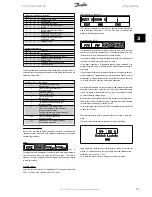
Gives the resulting reference in Hz in Open loop (parameter 100). In a
closed loop the reference unit is selected in parameter 416
Process
units
.
Feedback [unit], parameter 517:
Gives the resulting feedback value with the unit/scaling selected in pa-
rameters 414, 415 and 416. See also dealing with feedback.
Frequency [Hz], parameter 518:
Gives the output frequency from the frequency converter.
Frequency x scaling [-], parameter 519:
corresponds to the present output frequency f
M
multiplied by the factor
preset in parameter 008
Display scaling of output frequency
.
Motor current [A], parameter 520:
Gives the motor's phase current measured as an effective value.
Torque [Nm], parameter 521:
Gives the motor's present load in relation to the motor's rated torque.
Power [kW], parameter 522:
Gives the present power absorbed by the motor in kW.
Power [HP], parameter 523:
Gives the present power absorbed by the motor in HP.
Motor voltage, parameter 524:
Gives the voltage being supplied to the motor.
DC link voltage, parameter 525:
Gives the intermediate circuit voltage in the frequency converter.
Thermal load, motor [%], parameter 526:
Gives the calculated/estimated thermal load on the motor. 100% is the
cut-out limit. See also parameter 128
Thermal motor protection
.
Thermal load INV [%], parameter 527:
Gives the calculated/estimated thermal load on the frequency converter.
100% is the cut-out limit.
Digital input, parameter 528:
Gives the signal status from the 5 digital inputs (18, 19, 27, 29 and 33).
Input 18 corresponds to the bit on the extreme left. '0' = no signal, '1' =
connected signal.
Terminal 53 analogue input [V], parameter 529:
Gives the voltage value for the signal on terminal 53.
Terminal 60 analogue input [mA], parameter 531:
Gives the present value for the signal on terminal 60.
Pulse input 33[Hz], parameter 532:
Gives a pulse frequency in Hz connected to terminal 33.
External reference, parameter 533:
Gives the sum of external references as a percentage (sum of analogue/
pulse/serial communication) in the range from Minimum reference,
Ref
MIN
to Maximum reference, Ref
MAX
.
Status word, parameter 534:
Gives the present status word for the frequency converter in Hex. See
Serial communication for the VLT 2800.
Inverter temperature, parameter 537:
Gives the present inverter temperature on the frequency converter. The
cut-out limit is 90-100 °C, with cut back in at 70 ± 5 °C.
Alarm word, parameter 538:
Gives in Hex code which alarm is on the frequency converter. See
Warn-
ing word, extended status word and alarm word.
Control word, parameter 539:
Gives the present control word on the frequency converter in Hex. See
Serial communication for the FCD 300.
Warning word, parameter 540:
States whether there is a warning on the frequency converter in Hex. See
Warning word, extended status word and alarm word.
Extended status word, parameter 541:
States whether there is a warning on the frequency converter in Hex
code. See
Warning word, extended status word and alarm word.
Pulse count, parameter 544:
This parameter can be read out via the LCP display (009–012). When you
run with counter stop, this parameter enables you, either with or without
reset, to read the number of pulses registered by the device. The highest
frequency is 67.6 kHz, while the lowest is 5 Hz. The counter is reset when
counter stop is restarted.
Pulse input 29[Hz], parameter 545:
Gives a pulse frequency in Hz connected to terminal 29.
561
Protocol
Value:
FC protocol (FC PROTOKOL)
[0]
Metasys N2 (METASYS N2)
[1]
Modbus RTU
[3]
Function:
There is a choice of three different protocols.
Description of choice:
Select the required control word protocol.
For further information about using the Metasys N2 Protocol see MG91CX
and Modbus RTU see MG10SX.
570
Modbus parity and message framing
Value:
(EVEN/1 STOPBIT)
[0]
(ODD/1 STOPBIT)
[1]
(NO PARITY/1 STOPBIT)
[2]
(NO PARITY/2 STOPBIT)
[3]
Function:
This parameter sets up the drive’s Modbus RTU interface to communicate
properly with the master controller. The parity (EVEN, ODD, or NO PAR-
ITY) must be set to match the setting of the master controller.
Description of choice:
Select the parity that matches the setting for the Modbus master con-
troller. Even or odd parity is sometimes used to allow a transmitted word
to be checked for errors. Because Modbus RTU uses the more efficient
CRC (Cyclic Redundancy Check) method of checking for errors, parity
checking is seldom used in Modbus RTU networks.
571
Modbus communications timeout
Value:
10 ms - 2000 ms
100 ms
Function:
This parameter determines the maximum amount of time that the drive’s
Modbus RTU will wait between characters that are sent by the master
controller. When this amount of time expires, the drive’s Modbus RTU
interface will assume that it has received the entire message.
Description of choice:
Generally, the value of 100 ms is sufficient for Modbus RTU networks,
although some Modbus RTU networks may operate on a timeout value
as short as 35 ms.
If this value is set too short, the drive’s Modbus RTU interface may miss
a part of the message. Since the CRC check will not be valid, the drive
VLT® Decentral FCD
3 Programming
MG.04.B8.02 - VLT is a registered Danfoss trademark
83
3
















































